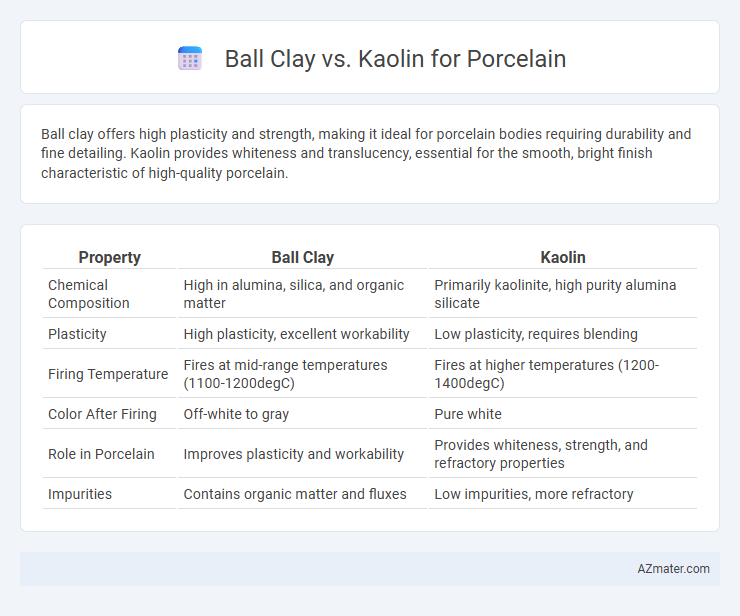Ball clay offers high plasticity and strength, making it ideal for porcelain bodies requiring durability and fine detailing. Kaolin provides whiteness and translucency, essential for the smooth, bright finish characteristic of high-quality porcelain.
Table of Comparison
| Property | Ball Clay | Kaolin |
|---|---|---|
| Chemical Composition | High in alumina, silica, and organic matter | Primarily kaolinite, high purity alumina silicate |
| Plasticity | High plasticity, excellent workability | Low plasticity, requires blending |
| Firing Temperature | Fires at mid-range temperatures (1100-1200degC) | Fires at higher temperatures (1200-1400degC) |
| Color After Firing | Off-white to gray | Pure white |
| Role in Porcelain | Improves plasticity and workability | Provides whiteness, strength, and refractory properties |
| Impurities | Contains organic matter and fluxes | Low impurities, more refractory |
Introduction to Ball Clay and Kaolin
Ball clay and kaolin are essential raw materials in porcelain production, each contributing unique properties that influence the final product's quality. Ball clay, composed of kaolinite, mica, and quartz, is prized for its plasticity, fine particle size, and high strength, making it ideal for shaping and molding porcelain items. Kaolin, also known as china clay, contains high levels of pure kaolinite and provides whiteness, translucency, and resistance to high temperatures, crucial for achieving porcelain's characteristic smooth and durable finish.
Geological Origins and Composition
Ball clay originates from sedimentary deposits rich in kaolinite, mica, and quartz, typically formed in ancient river or lake beds, whereas kaolin is a primary clay derived directly from the hydrothermal alteration of feldspathic rocks. The high plasticity of ball clay results from its high organic content and finer particle size, essential for shaping porcelain, while kaolin exhibits lower plasticity but higher whiteness and purity, contributing to the strength and translucency of the fired body. Geological differences influence mineral composition: ball clay contains 20-80% kaolinite with varying carbon and mica, while kaolin consists of over 90% kaolinite with minimal impurities, defining their respective roles in porcelain production.
Physical Properties Comparison
Ball clay exhibits higher plasticity and finer particle size compared to kaolin, making it ideal for shaping and plasticity in porcelain production. Kaolin has greater whiteness and lower shrinkage during firing, contributing to the porcelain's strength and translucency. The combined use of ball clay and kaolin balances workability with structural integrity, optimizing the physical properties required for high-quality porcelain.
Plasticity and Workability in Porcelain
Ball clay offers higher plasticity compared to kaolin, enhancing workability and allowing for easier shaping and molding of porcelain. Kaolin, while less plastic, contributes to the porcelain's whiteness and firing strength but requires blending with ball clay to improve flexibility. The optimal porcelain mix balances kaolin's purity and ball clay's plasticity for superior formability and strength.
Firing Temperatures and Thermal Behavior
Ball clay typically fires at lower temperatures ranging from 1180degC to 1250degC, offering excellent plasticity and workability that is ideal for porcelain bodies requiring smoother shaping. Kaolin, also known as china clay, demands higher firing temperatures around 1300degC to 1450degC, resulting in enhanced whiteness, translucency, and thermal stability essential for high-quality porcelain. The distinct thermal expansion properties of kaolin reduce warping and improve structural strength during firing, whereas ball clay contributes to better drying shrinkage control and flexibility in the green body phase.
Color and Whiteness After Firing
Ball clay typically produces porcelain with a warm, creamy hue due to its higher iron content, while kaolin offers superior whiteness and brightness after firing, making it the preferred choice for high-quality, white porcelain. The lower impurity level in kaolin enhances translucency and color purity, contributing to a more refined, bright-white finish. Manufacturers often blend ball clay and kaolin to balance workability with the desired whiteness and color characteristics in the final porcelain product.
Influence on Porcelain Strength and Durability
Ball clay enhances porcelain strength and durability due to its high plasticity and fine particle size, which improve workability and contribute to a denser fired body. Kaolin imparts whiteness and translucency but has lower plasticity, often resulting in porcelain that is more brittle unless combined with ball clay. The balance between ball clay's plasticity and kaolin's purity is crucial for optimizing the porcelain's mechanical strength and resistance to cracking.
Impacts on Glaze and Surface Finish
Ball clay contributes higher plasticity and iron content, resulting in a smoother glaze and enhanced workability for porcelain bodies. Kaolin offers superior whiteness and purity, producing a brighter, more translucent surface finish with fewer impurities affecting glaze coloration. The combination of ball clay and kaolin balances strength and aesthetic quality, optimizing glaze adherence and the overall porcelain texture.
Cost and Availability Factors
Ball clay offers a more cost-effective option for porcelain production due to its higher plasticity and lower price compared to kaolin, which is more expensive and purer. Availability of ball clay is generally broader and more consistent, making it a preferred choice for large-scale manufacturing, whereas kaolin deposits are more geographically limited and subject to market fluctuations. Manufacturers often blend ball clay with kaolin to balance cost efficiency and the desirable whiteness and strength of porcelain.
Choosing the Right Clay for Porcelain Production
Ball clay offers high plasticity and excellent workability, making it ideal for shaping porcelain, while kaolin provides purity and whiteness crucial for fine porcelain finishes. Selecting the right clay involves balancing ball clay's plastic strength with kaolin's refractory properties to achieve durability and translucency. Optimal porcelain production typically blends both clays to enhance formability and maintain the desired aesthetic quality.

Infographic: Ball clay vs Kaolin for Porcelain
 azmater.com
azmater.com